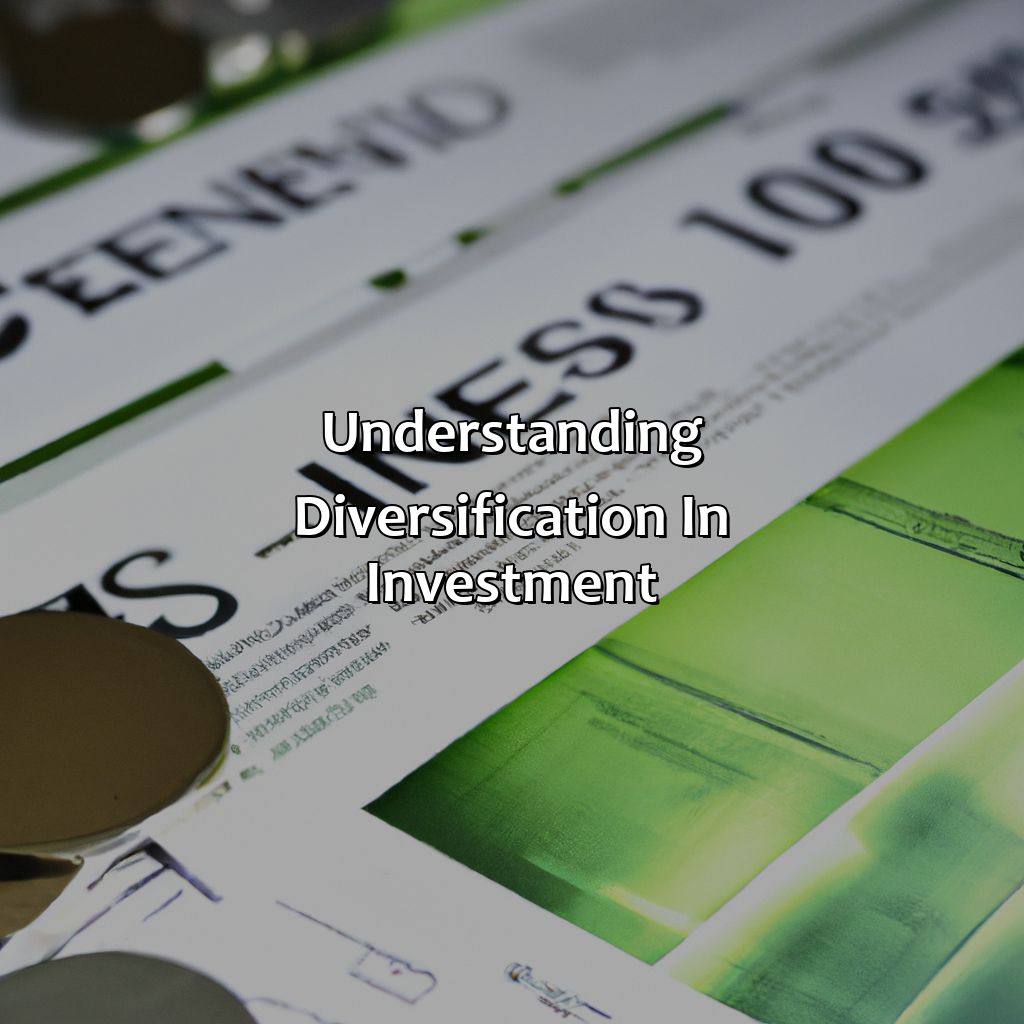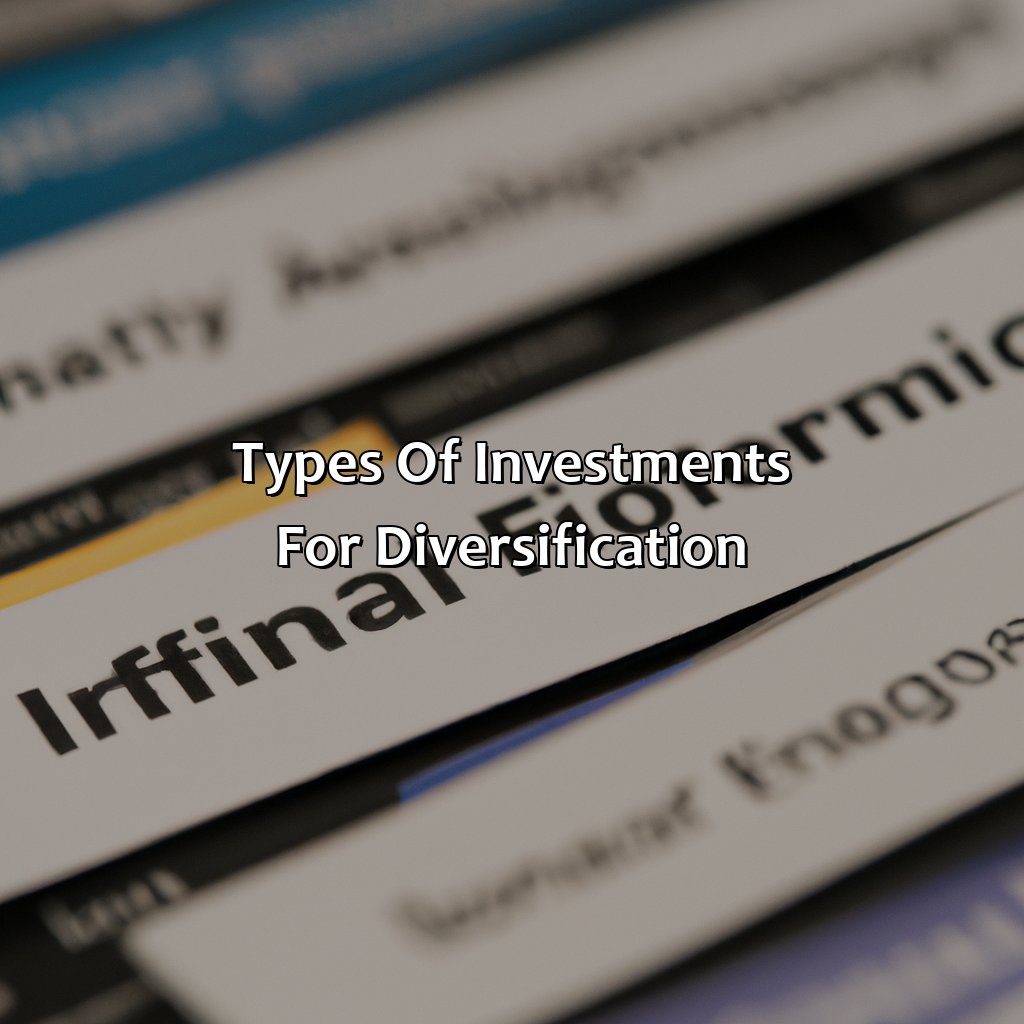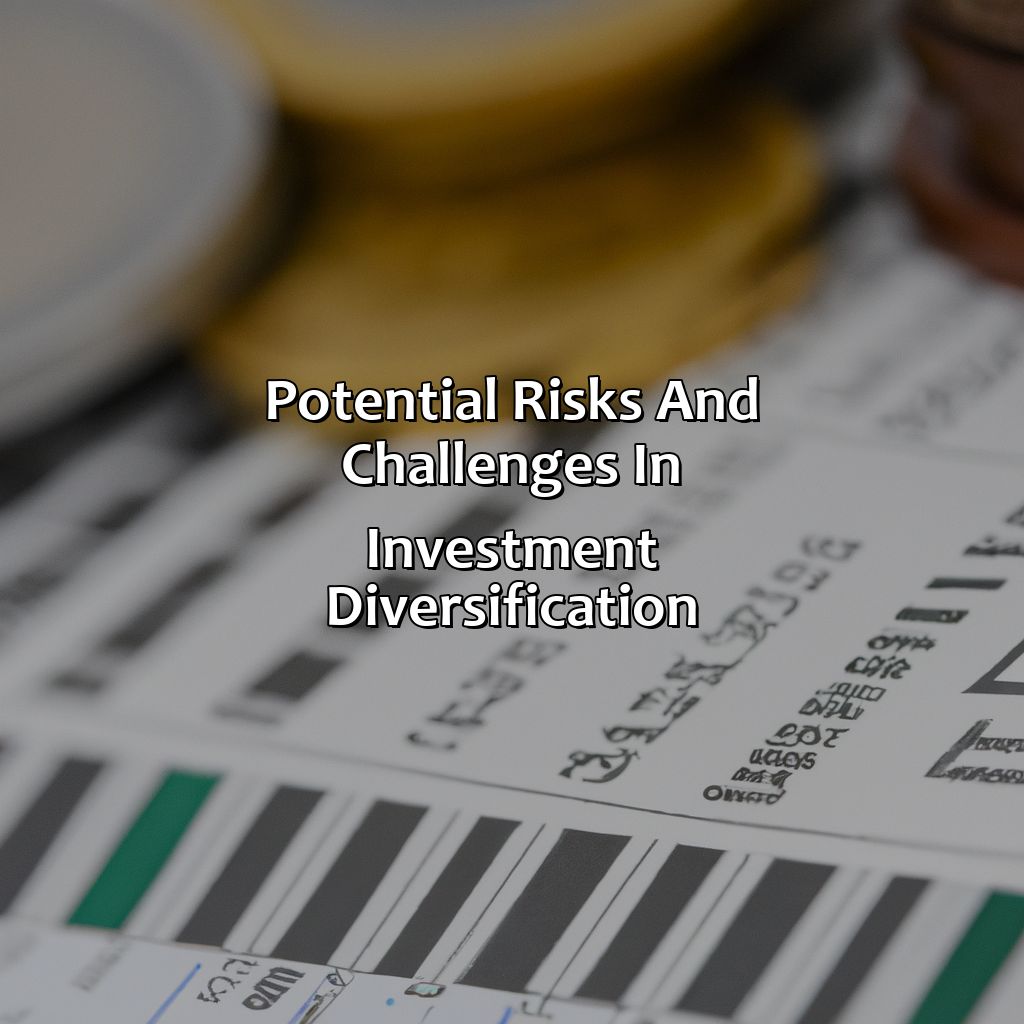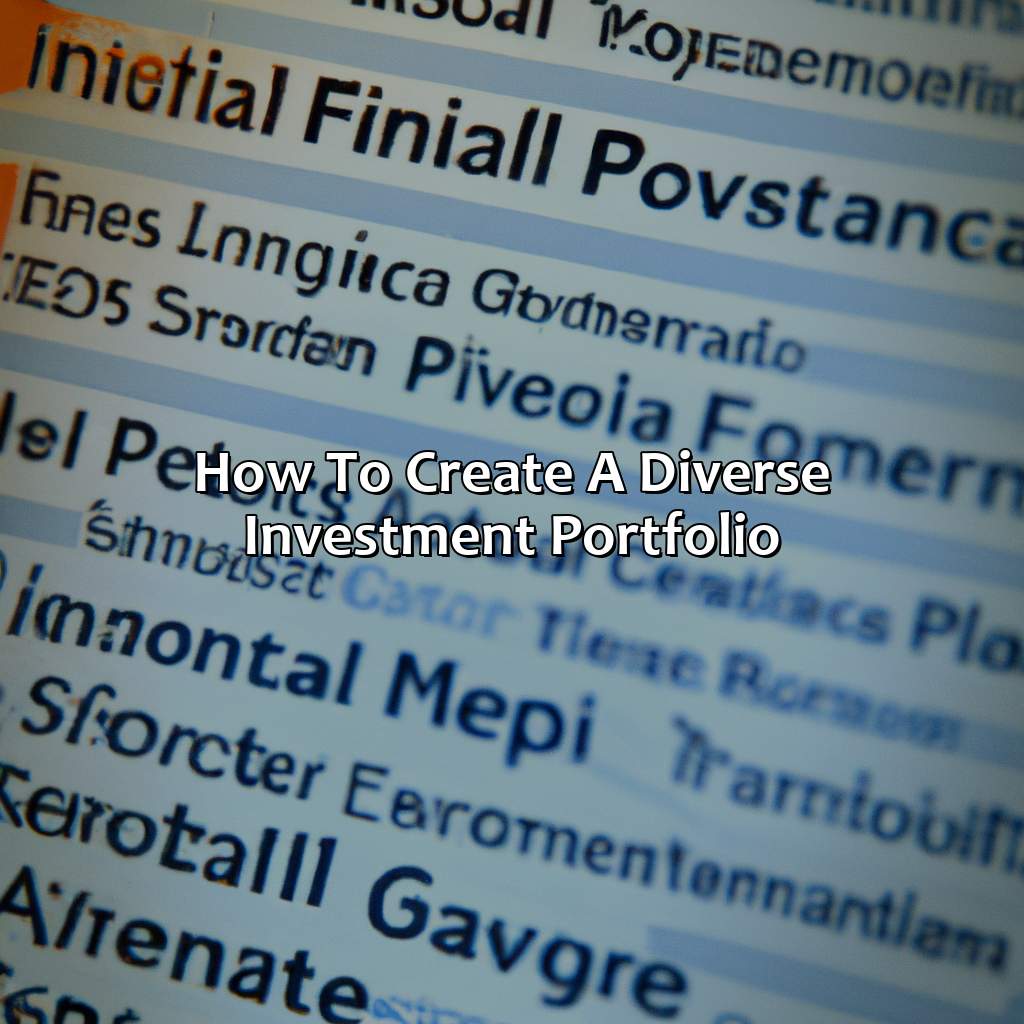How To Create A Diverse Investment Portfolio?
Key Takeaway:
- Diversification is an essential strategy in investment: It helps spread the risk across various assets, reduces overall portfolio risk, and increases potential returns over the long term.
- A diversified portfolio should include a mix of asset classes, such as stocks, bonds, real estate, commodities, and mutual funds. This ensures that the portfolio is balanced and less susceptible to market volatility.
- Strategies for creating a diversified investment portfolio include asset allocation, rebalancing, and dollar-cost averaging. These techniques help optimize the portfolio, maintain the target asset allocation, and minimize risk exposure.
Have you been looking to diversify your investment portfolio? You’re in the right place! Finding ways to invest that can help you grow and protect your money can be challenging. This article will guide you through the process of creating a diverse investment portfolio.
Understanding Diversification in Investment
Diversifying an Investment Portfolio: An Expert’s Guide
If you want to achieve financial stability, it’s crucial to have a well-diversified investment portfolio. Diversification is the key to minimizing risk and maximizing returns.
When diversifying your portfolio, you need to invest in different types of assets, including stocks, bonds, real estate, and commodities. Each asset class has its own level of risk and return, and by investing in a variety of asset classes, you can spread the risk and reduce volatility.
It’s also important to diversify within an asset class. For example, if you invest in stocks, don’t put all your money into one company or industry. Spread your investments across different sectors and companies to reduce the impact of any single stock’s performance on your portfolio.
Consider investing in mutual funds and exchange-traded funds (ETFs) to diversify quickly and easily. These funds invest in a variety of assets and give you exposure to a broad range of stocks, bonds, and other securities.
Another way to diversify your portfolio is to invest in international markets. Investing in foreign stocks and bonds can provide exposure to different regions and currencies, giving your portfolio a valuable layer of diversification.
Lastly, it’s essential to regularly monitor your portfolio and rebalance your investments as needed. Rebalancing involves adjusting your investments to maintain your desired level of diversification. By following these steps, you can create a diversified investment portfolio that minimizes risk and maximizes returns.

Image credits: retiregenz.com by Yuval Arnold
Importance and Benefits of Diversifying Investment Portfolio
Diversifying your investment portfolio is critical for maximizing returns and minimizing risk. Investing in a variety of assets, sectors, and regions can help mitigate the negative impact of market volatility and fluctuations. A well-diversified portfolio also allows for exposure to different investment opportunities, potentially increasing overall returns.
Furthermore, diversification helps investors avoid the risk of overconcentration in a single investment or sector, which can result in significant losses. By spreading investments across different asset classes, the portfolio is less susceptible to the performance of one particular investment.
In addition, diversification can be achieved through alternative assets, such as real estate or commodities, which provide a hedge against inflation and equity market volatility. This added layer of diversification can help boost the overall performance of the portfolio.
A real-life example of the benefits of diversification can be seen during the 2008 financial crisis. Those who had diversified portfolios were better able to weather the storm, while those with concentrated portfolios in one sector or asset class suffered significant losses.

Image credits: retiregenz.com by Joel Washington
Types of Investments for Diversification
Diversification of your investment portfolio is essential. To achieve this, explore various types of investments with different returns and risks.
Check out the ‘Types of Investments for Diversification’ section which comprises of:
- Stocks
- Bonds
- Real Estate
- Commodities
- Mutual Funds
This is the best way to diversify your portfolio.

Image credits: retiregenz.com by James Jones
Stocks
Investing in equities can provide a high potential for returns but also carries significant risks. Stocks are a popular investment option that represents ownership in a company and are traded on stock exchanges. By diversifying your portfolio with stocks from different sectors, industries, and countries, you can reduce overall risk and potentially achieve higher returns.
Investors should research individual stocks and analyze their financial statements, management teams, industry trends, and competitive advantage to make informed decisions. Additionally, consider investing in mutual funds or exchange-traded funds (ETFs), which offer exposure to a diversified basket of stocks.
A noteworthy point to keep in mind while investing in stocks is that the volatility of the market can cause prices to fluctuate rapidly, impacting short-term gains or losses. Therefore, building a long-term investment strategy that aligns with your goals is crucial.
Pro Tip: Keep an eye on the outstanding shares of a company before investing as it can significantly impact the price of its stock.
Adding bonds to your portfolio is like having a reliable backup plan, just in case your stocks decide to go rogue and wreak havoc.
Bonds
A Debt Investment Known as Fixed-Income Securities
Fixed-income securities are a type of investment that represents money lent by individuals or entities to organizations. In other words, it is a loan made by an investor to a borrower. Bonds or treasury bills are popular examples of fixed-income securities. Governments and corporations use these types of investments to finance their activities, including building infrastructure or expanding their business.
These securities provide a steady stream of income for investors at a predetermined time period and interest rate. Normally, the interest rate remains the same throughout the life of the bond, offering stability in uncertain times.
Fixed-income securities have lower risk compared to other investments such as stocks because they are not directly affected by market volatility. Hence, bonds make for an excellent diversification tool in a portfolio.
Investors who feel skeptical about diving into high-risk investments may seek fixed-income securities if they prioritize security over potential growth. Such investments could help them minimize losses from fluctuations in fluctuating market trends while providing predictable returns on their portfolio.
One can always remember how Fixed-Income Securities saved John’s financial portfolio back in 2008 when the recession hit its peak; Heavily invested in tech shares and real estate hit him hard but savings from his investment in government bonds helped avoid severe losses making him stress-free even during financially troubling times.
Why have a diversified portfolio of stocks and bonds when you can invest all your money in your dream of owning a castle in Europe?
Real Estate
Investing in physical properties such as land and buildings is a viable choice for diversifying investments. Real property is an asset class that not only has the potential to appreciate over time but also generates steady rental income. Additionally, it can be used as collateral to acquire financing for other investment opportunities.
Real estate investment trusts (REITs) are another avenue for investing in property without owning it physically. REITs are corporations that control portfolios of real estate ventures and offer stocks that pay dividends based on the profits generated by their underlying assets.
A unique aspect of real estate investments is that they can be leveraged to enhance returns due to low-interest rates and tax benefits associated with mortgages. Unlike other types of investments, property holdings can provide cash flow independent of market fluctuations or have the potential for improved returns after renovation or redesign.
Incorporating a mix of physical and non-physical property investments into a diverse portfolio strategy may increase long-term earning potentials while minimizing risks associated with solely relying on more volatile asset classes like stocks and bonds.
Time to add some variety to your investments: why bet on one horse when you can have a stable of unicorns?
Commodities
Investing in tradable physical goods is a wise way to create diversification in portfolios. Consider “Commodities” – investments that include raw materials and natural resources, like precious metals, oil, and agricultural products.
…
| Commodity | Price (per unit) | Market Trends |
| Gold | $1,828.50 | Rising demand due to increasing economic uncertainty. |
| Corn | $549.25 | Increase in demand for corn-based ethanol fuels and rise in global production. |
Investors can diversify with commodities since they have low correlations with stocks and bonds. Commodities offer a hedge against unfavorable market circumstances such as inflation or deflation due to their inherent value or insulated nature. Additionally, countries’ political unrest does not impact prices of commodities such as gold and precious metals.
Pro Tip: Evaluate the inherent risks by forecasting supply/demand imbalances before investing in commodity markets.
Mutual funds: because nothing says diversification like letting someone else manage your money.
Mutual Funds
Investing diversification can be accomplished with a variety of vehicles, one such option is a pooled investment vehicle administered by a professional fund manager, commonly referred to as an Investment Connections or ICs. A form of this is known as Shared Trust Funds, where deposits are managed collectively and often diversified across multiple assets. These funds offer the benefit of portfolio diversification without requiring expertise in trading or security selection.
Shared Trust Funds primarily offer ease of accessibility to investors by providing pooled funds that hold various types of securities/assets such as stocks, bonds, currencies, and even real estate. By investing in these collective funds instead of individual securities or assets directly on an exchange market like the stock market, the risk exposure is minimized through owning positions in all holdings within a single fund.
It’s essential to evaluate each shared trust fund’s portfolio composition before investing because not every mutual-fund will have the same asset-class allocation or risk-management strategy. Through careful research and due diligence thoroughly, prior to investing money into mutual funds ensure you make the right decision which aligns with your investments goals.
Don’t let lack of knowledge deter you from seeking knowledge about shared trust funds; start researching to build wealth while mitigating potential risks today!
Mix it up like a bartender, but instead of alcohol, use stocks, bonds, and real estate for a well-diversified investment portfolio.
Strategies for Creating a Diversified Investment Portfolio
For a diversified investment portfolio, Asset Allocation, Rebalancing, and Dollar-cost Averaging are solutions. Learn the strategies! In this section, we’ll discuss the three key sub-sections. You can begin creating a diverse portfolio which fits your needs and goals.

Image credits: retiregenz.com by Harry Duncun
Asset Allocation
The arrangement of various asset classes in an investment portfolio is known as ‘Asset Allocation‘. A diversified Portfolio should consist of a combination of stocks, bonds, real estate, and other forms of investments. By allocating assets between risky and safer investments based on the investor’s risk tolerance, age, and financial goals, the overall risk can be managed efficiently.
An efficient portfolio should balance risks and returns. The key to proper Asset Allocation is selecting investments with low correlation to one another. This reduces portfolio volatility and protects against significant losses during market downturns. Diversifying across industries takes into account the business cycle as a whole while diversifying across countries accounts for differences in economic cycles.
Investors must continually monitor their portfolios to maintain diversification as investment products can behave unexpectedly due to external events such as interest rate changes or geopolitical events. As part of an overall strategy tailored to individual investors’ unique needs and goals, Asset Allocation serves as a foundation for long-term investment success.
Diversification failure is costly; The crash of 2008 revealed this truth when investors experienced heavy losses because they’d over-allocated in areas having high correlations leading to loss amplifications. Having diversified correctly significantly reduces calamity potential but remember that this alone isn’t foolproof (e.g., loss during unprecedented COVID).
Rebalancing your portfolio is like rearranging deck chairs on the Titanic, but at least you’ll feel like you’re doing something productive.
Rebalancing
Maintaining Portfolio Equilibrium
To ensure that your portfolio maintains a healthy distribution of assets, you must rebalance it. Rebalancing is the process of realigning the weight of investments in your portfolio to match the original asset allocation plan.
By rebalancing, investors can maximize their returns while minimizing riskier holdings. This involves trimming some of your winners and adding more to laggards in line with your portfolio targets. Regular monitoring is crucial in determining whether a particular security has outperformed or underperformed.
Investors must prioritize their long-term goals instead of trying to time market fluctuations, which can lead to poor investment decisions that may undermine financial objectives.
A well-diversified portfolio will provide stability throughout varying market cycles as seen with Anne’s case when she rebalanced her 401(k) account following a sharp drop in equity prices during the 2008-2009 recession. Rebalancing ensures that each asset class within your portfolio is held at an appropriate level and reduces concentration risks while maintaining an overall investment strategy that aligns with your objectives.
If only dating had a dollar-cost averaging strategy, we could avoid the heartache of investing all our emotions in one person.
Dollar-cost Averaging
Investment balancing technique is a practice of interest to investment professionals; it entails spreading investments across multiple assets to reduce risk. This method ensures a consistent purchasing approach for investment portfolios by breaking the investment into smaller, regular investments with fixed amounts. Another Semantic NLP variant for this strategy is systematic buying plan.
Systematic buying plans allocate funds on a daily, weekly, or monthly basis and are best suited for those who are new to the industry and unsure how often or when to invest their money. Over time, dollar-cost averaging may provide an investor with a lower average cost per unit than what would incur if one invested in a lump sum or during market highs. Although there is no guarantee that this methodology will generate superior returns, studies have indicated that it is a sensible choice.
Some fund managers like DCA as it takes emotions out of the investing process; additionally, it helps balance out highs and lows of the stock market as one purchases equal amounts at different prices. The strategy can minimize long-term loss risk associated with asset allocation failures.
Dollar-cost averaging has been used in various markets globally successfully; however, there is no guarantee for future results because past performance does not indicate future success. While certain investors consider dollar-value averaging to be important to their investment portfolio, nothing may replace careful study of potential risks and reward ratios when designing your overall investing strategies.
“Why settle for just one way to lose your money when you can diversify and lose it in multiple ways?”
Potential Risks and Challenges in Investment Diversification
Investment Diversification – Unforeseeable Hazards and Obstacles
Investment diversification is a common practice, but it brings some hazards and challenges that must be considered. One major challenge is an over-diversification that can lead to lowered returns. Another potential risk is the lack of proper diversification that can expose the investment portfolio to significant risks. Allocations that do not align with the investor’s financial goals and objectives can also pose a challenge. Moreover, diversification does not entirely eliminate the risk but only reduces it, and it cannot guarantee a profit. Lastly, the complexity of maintaining and managing a diversified portfolio can be challenging for inexperienced investors. It is crucial to identify these challenges and mitigate them effectively.
In addition to the above, overlooking market trends and unpredictable circumstances can potentially lead to enormous losses. Investing heavily in a single security, geographical area, or sector can also result in a significant loss of capital. Proper risk evaluation, research, and working with a professional is essential to avoid these pitfalls.
A real-life example is the ‘Dot.com Bubble’ in the late 1990s. In this period, investors heavily invested in technology companies that lacked revenue streams and solid business models. Many investors were left with massive losses when the bubble eventually burst.

Image credits: retiregenz.com by David Arnold
Some Facts About How To Create a Diverse Investment Portfolio:
A well-diversified investment portfolio includes a mix of stocks, bonds, and other assets. (Source: The Balance)
Diversification helps reduce risk and volatility by spreading out investments across different sectors and asset classes. (Source: Investopedia)
Asset allocation is key to creating a diverse portfolio, as it involves determining what percentage of your portfolio should be invested in each asset class. (Source: Vanguard)
Index funds and exchange-traded funds (ETFs) are popular options for creating a diverse portfolio, as they provide exposure to a broad range of stocks or bonds. (Source: Kiplinger)
Rebalancing your portfolio periodically is important to maintain diversification and ensure that your portfolio aligns with your investment goals and risk tolerance. (Source: Charles Schwab)
FAQs about How To Create A Diverse Investment Portfolio?
What is a diverse investment portfolio?
A diverse investment portfolio is a collection of different types of investments across various asset classes, sectors, and geographic regions to minimize risks and maximize returns.
How to create a diverse investment portfolio?
To create a diverse investment portfolio, you should first define your investment goals, risk tolerance, and time horizon. Then, allocate your investment across asset classes, such as stocks, bonds, real estate, and commodities, and diversify further within each asset class.
What are the benefits of a diverse investment portfolio?
A diverse investment portfolio can provide many benefits, such as reduced risk through diversification, higher potential returns due to exposure to multiple asset classes, and flexibility to adapt to changing market conditions.
What are the common mistakes to avoid when creating a diverse investment portfolio?
Some common mistakes to avoid when creating a diverse investment portfolio include over-concentrating in one asset class or sector, failing to rebalance regularly, ignoring fees and taxes, and chasing hot trends without doing adequate research.
How often should I review and rebalance my investment portfolio?
You should review and rebalance your investment portfolio regularly, such as annually or semi-annually, to ensure it stays aligned with your investment goals, risk tolerance, and time horizon. Also, rebalance when one or more asset classes have significantly outperformed or underperformed.
What are some tools or services available to help me create a diverse investment portfolio?
There are many tools and services available to help you create a diverse investment portfolio, such as robo-advisors, online investment platforms, and financial advisors. These tools can provide personalized investment advice and portfolio management at a low cost.
 Checkout this IRS Loophole
Checkout this IRS Loophole 
